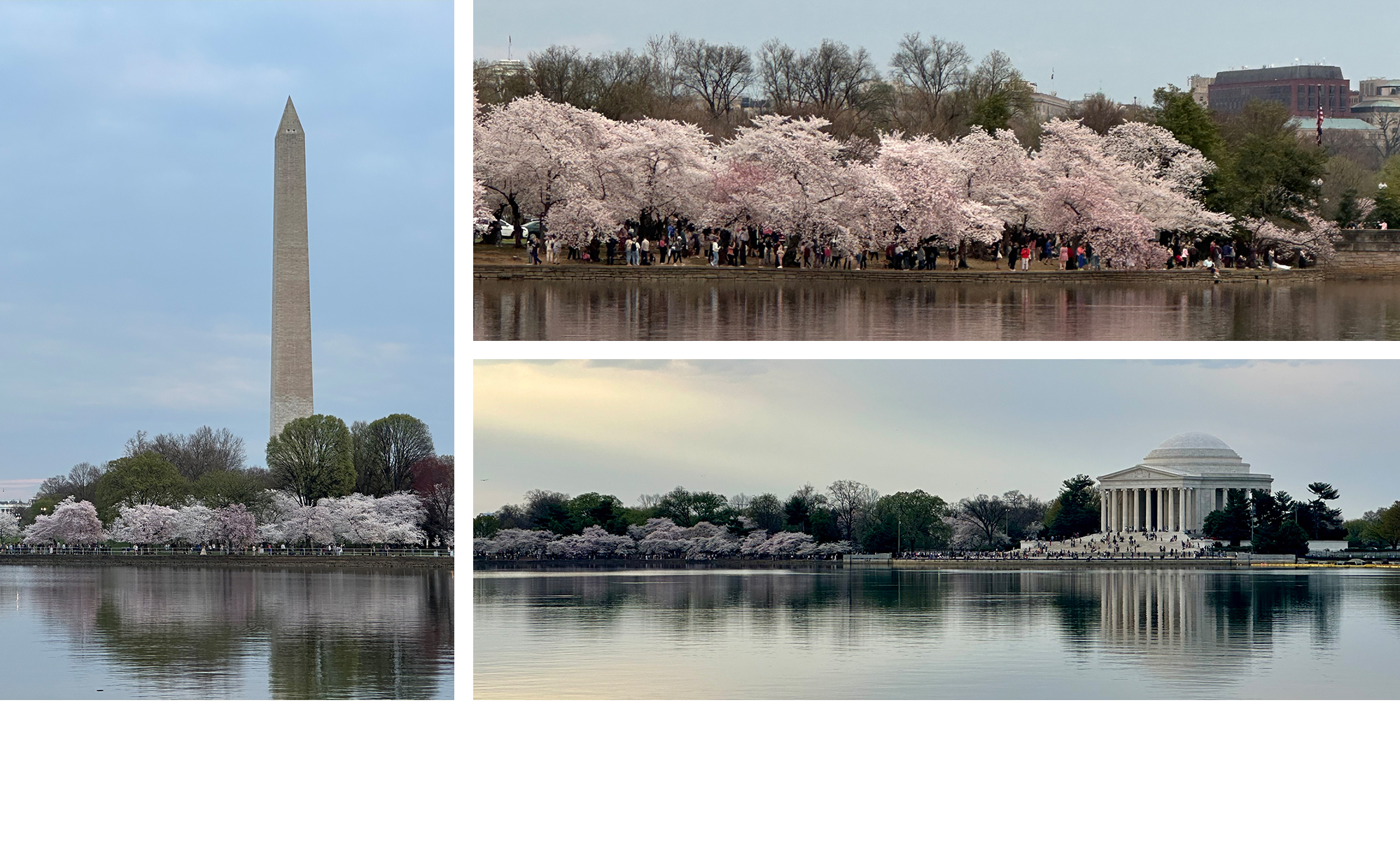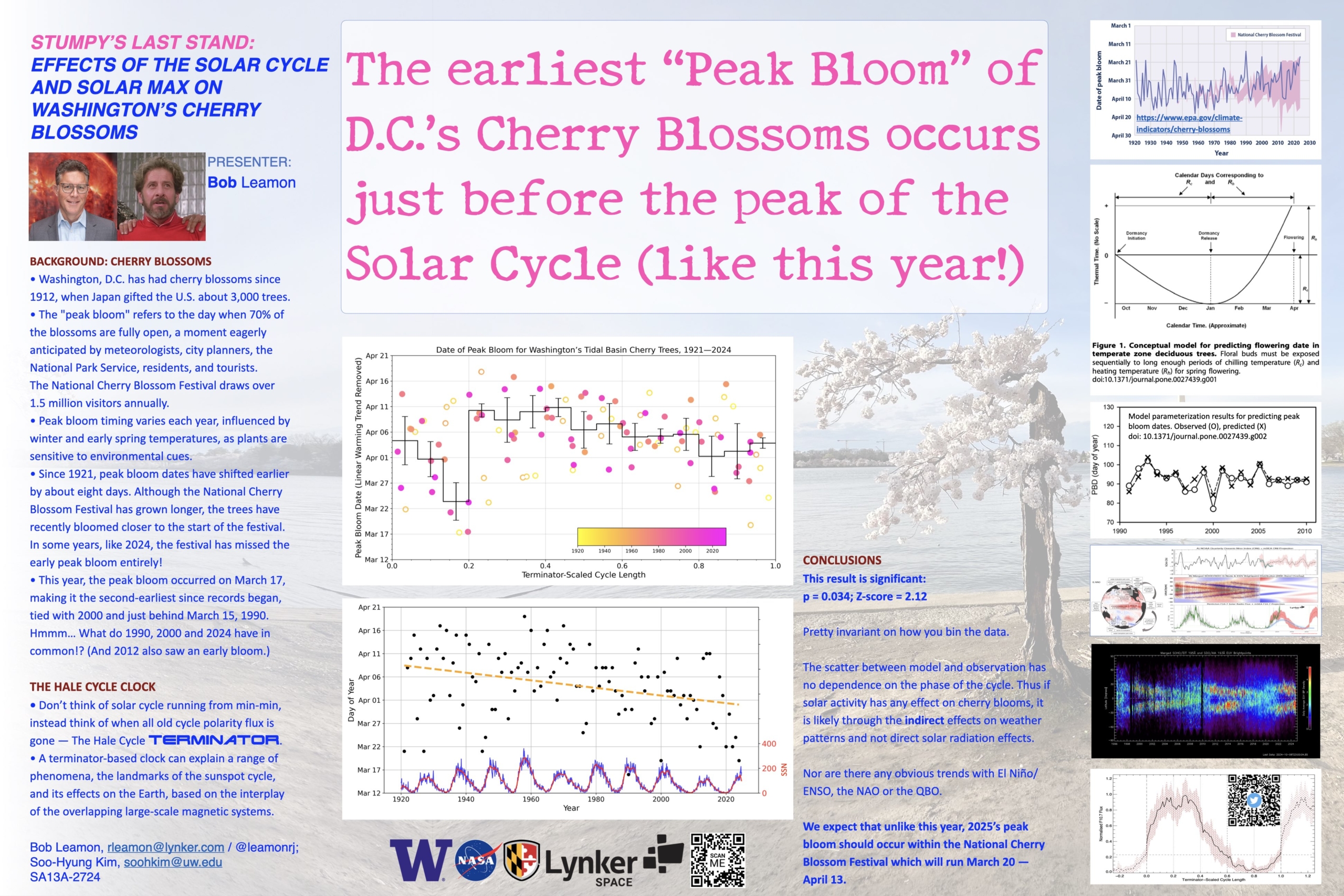Cherry Blossoms & Solar Cycles: Predicting Peak Bloom Years in Advance
 The coordinated appearance of Cherry blossoms is an icon of spring. Might their riot of color not only be an indicator of increasing spring sunshine, but of how the sun affects us in subtle unseen ways!?
The coordinated appearance of Cherry blossoms is an icon of spring. Might their riot of color not only be an indicator of increasing spring sunshine, but of how the sun affects us in subtle unseen ways!?
The National Cherry Blossom Festival is “Washington’s Grandest Springtime Tradition” and draws over 1.5 million visitors annually.
Washington, D.C. has had cherry blossoms since 1912, when Japan gifted the U.S. about 3,000 trees. The “peak bloom” refers to the day when 70% of the blossoms are fully open, a moment eagerly anticipated by meteorologists, city planners, the National Park Service, residents, and tourists. Peak bloom timing varies each year, influenced by winter and early spring temperatures, as plants are sensitive to local environmental cues.
“How much is it worth to the District to accurately predict peak bloom two, three, four years out?”
“You heard it here first! We’re predicting #CherryBlossom Peak Bloom to fall between March 28-31 this year.”
So said the National Park Service in a post (tweet) on X making their announcement on Thursday February 27 (https://x.com/NationalMallNPS/status/1895154004063330645).
The NPS makes the Official Prediction, and they nailed it – from 4 weeks out. Peak Bloom was called March 28. Metro recorded record ridership over the weekend, and traffic cameras on the I395 bridge showed backups extending miles, past the Pentagon. (I went down at dawn Saturday, and around the Tidal Basin was packed even that early!)
But what if I said that April 1 LAST YEAR, we made the prediction of April 1-3, 2025, because of 2024’s super early peak bloom, and the discovery of a relationship between earlier and later Peak Blooms and the Sun’s roughly 11-year activity cycle…!
Last March’s Peak Bloom was super early (March 17, tied with 2000 for 2nd earliest since records began, behind only March 15, 1990), and even preceded the official start of the National Cherry Blossom Festival and its events and activities.
What do all those years have in common? They’re all just before “Solar Max,” the peak of the solar cycle. Even though 2012 “only” had its Peak Bloom on March 22, it was also relatively early, compared to the rest of the (relatively weak) previous Solar Cycle that peaked back then.
The second part of the predictions is that in the following year or two, after solar max, it’s far more likely that the peak bloom will be relatively late. (Phew!?)
“How much is it worth to the District to accurately predict peak bloom two, three, four years out?”
The increasing urbanization of the DMV and the associated “heat island effect” likely has more of an influence on Washington’s Peak Bloom than more global climate changes, but the Peak Bloom date has been getting earlier and earlier – about 8 days over the century of recorded measurements, but accelerating over the last 25-30 years. (The same is true for the Imperial Palace in Japan, which has kept Cherry Blossom records since 812 AD!)
We don’t have a definitive mechanism yet, but our leading hypothesis is from a series of scientific papers from the 1970s (by Walter O. Roberts, the founding director of NCAR’s High Altitude Observatory in Boulder, CO) that tie the changing number of geomagnetic storms in winter months nudging the tracks of winter storms that sweep in from Siberia and Arctic Canada, leading to more unsettled and cooler weather in and around Washington DC.
Having been a resident of DC since 2004, I can vouch for the fluctuations in winter severity and temperatures throughout the solar activity cycle. And it was fun to present work about my adopted hometown and its iconic blooms at December’s American Geophysical Union conference here in Washington.

Finally, it was announced this week that as a symbol of friendship, Japan is gifting Washington, DC, with 250 more cherry blossom trees to celebrate the 250th anniversary of America’s founding.
(https://x.com/JapanEmbDC/status/1906827807558078967)
Regardless of when temperatures get warm enough for those new trees’ Peak Bloom in the coming years, they will get warm enough, and there will be a riot of pink flowers in and around the Tidal Basin and the District for residents and visitors alike to get out and enjoy!
Bob Leamon is Lynker’s Lead Space Weather Scientist.
This was a fun little interlude, but our bread and butter at Lynker Space is understanding how the sun works and the impacts of space weather. If you are an operator in low earth orbit or on the ground, including commercial crop plantings, and were breathing a sigh of relief that ‘solar max’ had passed, then think again! Are you sure that you won’t be affected by a doubling of the space weather effects on your systems? If you need some assurance, drop us an email at info@lynker-space.com, find us on X @LynkerSpace, or on LinkedIn. We can help you understand what is going on and how our unparalleled insight can help protect your systems.